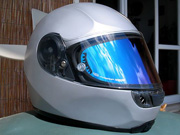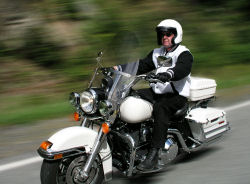Motorcycle Accidents
Motorcycle Accident Safety: Wearing The Right Helmet
 For motorcyclists, the most effective way to prevent a brain injury is to wear a helmet. An unhelmeted motorcyclist is 40 percent more likely to suffer a fatal head injury in a motorcycle crash than one wearing a helmet, according to the National Highway Traffic Safety Administration (NHTSA).
For motorcyclists, the most effective way to prevent a brain injury is to wear a helmet. An unhelmeted motorcyclist is 40 percent more likely to suffer a fatal head injury in a motorcycle crash than one wearing a helmet, according to the National Highway Traffic Safety Administration (NHTSA).
In Massachusetts and 19 other states, wearing a motorcycle helmet is the law for all riders. Twenty eight other states have laws requiring certain motorcyclists wear helmets. Three states, including New Hampshire, do not require motorcycle helmets for any riders.
Helmet use has grown in recent years as safety education has increased and manufacturers produce lighter-weight helmets. Helmet use increased from 48 percent of U.S. motorcyclists in 2005 to 67 percent in 2009, according to the NHTSA.
If you are a motorcyclist, it is important to protect yourself from motorcycle accidents as well as comply with the law. Our Boston motorcycle accident lawyers share some background information and tips for purchasing your motorcycle helmet:
Types of Helmets. Be sure to buy a helmet which is specifically designed for motorcycling. You may use different helmets for other activities, but these do not provide adequate protection in case of a motorcycle accident.
There are three types of helmets: full-face helmets; three-quarter, open-face helmets and “shorty” half helmets. A full-face helmet covers your entire face and provides the most protection. It has a moveable face shield which protects your eyes from debris and face in a motorcycle accident.
A three-quarter, open-face helmet has many of the same features, minus the face and chin protection of a full-face helmet. If you use an open-face helmet, it is recommended you also use a snap-on face shield or a pair of safety goggles when you ride.
The last type of helmet, a “shorty” half-helmet is not recommended by most safety organizations. It protects very little of your head and is the most likely to come off when you ride.
Safety Ratings. Since 1980, all adult-sized helmets for highway use have been required to meet the Department of Transportation (DOT) standards. Make sure your helmet has a DOT sticker before you purchase. The Snell Memorial Foundation is another safety testing laboratory for motorcycle helmets, though this rating is voluntary for helmet manufacturers.
Helmet Size. Most helmets are marked small, medium, large or extra large. Fit is important so measure your head at the largest circumference and contact your manufacturer to ask what size that measurement fits.
The goal is to avoid buying a helmet which is too large and can fall off. Here are a few things to note. The cheek pads should touch your cheeks without pressing uncomfortably. On full-face helmets, press on the chin piece. The helmet or face shield should not touch your nose or chin. There should be no gaps between your temples and brow pads. If the helmet has a neck roll, it should not push the helmet away from the back of your neck.
Replacing and Caring for Helmets. Follow the manufacturer’s instructions for caring for your helmet. It is best to use mild soap, water and a soft cloth. Avoid any petroleum-based cleaning fluid, which can cause the helmet to decompose over time.
Replace your helmet if the face shield is scratched as this will obstruct your view when riding. You should also replace your helmet if you’re involved in a motorcycle crash or if you notice any damage. Otherwise, many manufacturers recommend replacing your motorcycle helmet every two years.
Related:
- What You Should Know About Motorcycle Helmets, Motorcycle Safety Foundation
- Motorcycle and Bike Helmet Use Laws, Insurance Institute for Highway Safety
The Boston motorcycle accident lawyers at Breakstone, White & Gluck have over 80 years combined experience handling motorcycle accident cases in Massachusetts. If you have been injured, it is important to learn your rights. For a free legal consultation, contact us today at 800-379-1244 or 617-723-7676 or use our contact form.
Motorcycle Accidents Are Top Concern During Motorcycle Safety Awareness Month
 May has arrived and as motorcycling season begins, the National Highway Traffic Safety Administration (NHTSA) is observing Motorcycle Safety Awareness Month.
May has arrived and as motorcycling season begins, the National Highway Traffic Safety Administration (NHTSA) is observing Motorcycle Safety Awareness Month.
The national initiative aims to encourage drivers and motorcyclists to “share the road” and highlights that motorcycles are vehicles with the same rights and privileges as any other motor vehicle on the road.
This is an important point because most motorcycle accidents involve passenger vehicles and trucks. Many motorcycle accidents result from a lack of understanding and awareness on the part of both or either party. Many times, drivers will say they fail to see motorcyclists until just before an accident.
In 2009, motorcyclists were 25 times more likely than passenger vehicle occupants to die in a crash, according to the NHTSA. Motorcyclists were five times more likely to be injured based on miles traveled.
But motorcyclists can take a number of safety steps to protect themselves on the road. The Boston motorcycle accident lawyers at Breakstone, White & Gluck share a few motorcycle safety tips:
Wear a Helmet. Wearing a helmet is the best way to protect yourself from serious head injury. An unhelmeted motorcyclist is 40 percent more likely to suffer a fatal head injury in a motorcycle crash than one wearing a helmet, according to the NHTSA. Massachusetts is one of 19 states which require all motorcyclists to wear helmets. State law also requires all scooter and “low-power” riders to wear helmets.
Select a full-face helmet for the best protection. An open-faced helmet provides the next highest level of safety.
To select the right helmet, look for one which meets Department of Transportation (DOT) standards. All adult helmets are required to meet this standard and it will be clearly labeled on the helmet. The Snell Memorial Foundation is another well-respected testing organization to seek out, but helmet manufacturers are not required to meet its standards.
Take a Safety Class. Take an annual class on motorcycling safety to learn important techniques such as splitting lanes and how to handle road conditions such as uneven pavement and railroad tracks.
Wear Brightly Colored Clothing. Your goal is to make yourself as visible as possible to drivers during the day as well as night. Consider bright colors for your clothing and helmet.
Look in the Car’s Side View Mirrors. On the road, your best position is to be able to see the driver’s eyes in the side view mirror. If you cannot, you are in the vehicle’s blind spot, meaning the driver cannot see you in the mirror when he makes a driving decision.
Splitting Lanes. This is when a motorcycle moves in between two vehicles in separate lanes. Make sure you have the experience to make this move and make sure drivers around you are alert.
Avoid Riding in Inclement Weather. The risk for personal injuries increase in the rain and other bad weather conditions.
Related:
- Motorcycles, National Highway Traffic Safety Administration
- 7 Tips for Motorcycle Safety, Massachusetts Department of Transportation
- Motorcycle and Bicycle Helmet Use Laws, Insurance Institute for Highway Safety
- Motorcycle Safety Awareness Month Reminds Drivers, Riders to Share the Road, Consumer Reports
The Boston motorcycle accident lawyers at Breakstone, White & Gluck have over 80 years combined experience handling motor vehicle and motorcycle accident cases in Massachusetts. If you have been injured, it is important to learn your legal rights. For a free legal consultation, contact us today at 800-379-1244 or 617-723-7676 or use our contact form.

